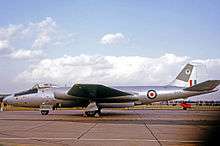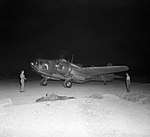No. 13 Squadron RAF
No. 13 or XIII Squadron is a squadron of the Royal Air Force formed on 10 January 1915 and most recently disbanded on 13 May 2011. It reformed on 26 October 2012 flying the MQ-9 Reaper unmanned aerial vehicle from RAF Waddington.[2] Aircraft previously operated by the squadron included the Martinsyde G.100, the Royal Aircraft Factory F.E.2, the SPAD VII and SPAD XIII, the Sopwith Dolphin, Lysanders, Mosquitos, Meteors and Canberras. From 1990 it operated the Panavia Tornado, initially the GR1A at RAF Honington and later the GR4/4A at RAF Marham.[3]
| No. XIII Squadron RAF | |
|---|---|
 | |
| Active |
|
| Country | |
| Branch | |
| Type | Remotely Piloted Air System squadron |
| Role | Intelligence, Surveillance, Target Acquisition and Reconnaissance (ISTAR) and attack |
| Part of | No. 1 Group RAF |
| Home station | RAF Waddington |
| Nickname(s) | 'The Stabbed Cats' |
| Motto(s) | Adjuvamus tuendo (Latin for 'We assist by watching')[1] |
| Aircraft | General Atomics MQ-9A Reaper |
| Battle honours |
|
| Insignia | |
| Squadron badge heraldry | In front of a dagger, a lynx's head affrontee. The Squadron had used the dagger for some time and the lynx's head indicates vigilance. Approved by King George VI in February 1937. |
| Squadron Roundel |  |
History
No. XIII Squadron formed at RAF Gosport on 10 January 1915 and moved to France on 19 October 1915, initially on Army co-operation duties and subsequently on bombing raids, pioneering formation bombing. Aircraft types operated during the war included the Martinsyde G.100, the Royal Aircraft Factory F.E.2, the Royal Aircraft Factory R.E.8, both the SPAD VII and SPAD XIII, and the Sopwith Dolphin. The squadron disbanded on 31 December 1919.[4]
The unit reformed at RAF Kenley on 1 April 1924 and inter-war years saw the squadron operate from various UK bases equipped with a variety of aircraft types including the Bristol F.2, Atlas, Audax and Hector.[4]

By January 1939 the squadron was equipped with Lysanders and moved to France on 2 October until late May 1940 when it withdrew to UK bases. In May 1941 No. XIII Squadron changed role and theatre, flying a variety of bomber aircraft including the Bristol Blenheim and Douglas Boston in the Mediterranean until the end of the War.[5]
Peace heralded the return to reconnaissance duties, originally with Mosquito then Meteors and Canberras, operating from Egypt, Cyprus and Malta. During the 1956 Suez Crisis, the squadron flew reconnaissance flights over Syria from Cyprus, which resulted in one Canberra being shot down by the Syrian Air Force.[6]
In 1978 the squadron moved to RAF Wyton near Huntingdon in the UK, flying Canberra PR.7 and PR.9s, built by Short Brothers, until the unit disbanded on 1 January 1982.[5]
Gulf War
The squadron reformed at RAF Honington on 1 January 1990 equipped with reconnaissance Tornado GR.1A aircraft. These aircraft were equipped with the new and somewhat embryonic reconnaissance equipment designed to exploit the night, all-weather capability of the Tornado by using a unique system of infra-red sensors and video recorders. The complete system is carried and allows the Navigator to either view the imagery in real time or later in the mission. As the Allied Coalition began to deploy forces to the Gulf in the latter part of 1990, it quickly became apparent that the unique night reconnaissance capability of the Tornado GR.1A could provide vital intelligence to the Allied commanders. As a result, on 15/16 January 1991, immediately before hostilities commenced, 6 aircraft were deployed to Saudi Arabia. During the first nights of the War, the Reconnaissance Wing successfully discovered several of the elusive Scud sites.[7]
The majority of sorties were however, tasked into Central and Eastern Iraq to identify the disposition of the various Iraqi ground forces in preparation for the ground offensive. Although the rest of the Coalition Air Forces moved to medium level operations after the first few nights of the air war, the GR.1As operated at night and at low-level for the duration of the conflict. The Squadron was also fundamental to the success of the Tornado/TIALD (Thermal Imaging And Laser Designation) combination. 4 XIII Squadron crews began the work-up from mid-January and, after encouraging results, four aircraft flew to Tabuk.[8]
After the war, the Squadron continued its peacetime training role at RAF Honington as well as taking part in Operation Jural, the monitoring of a No-Fly Zone in the South of Iraq below the 32nd parallel north.[9]
Marham
On 1 February 1994, No XIII Squadron moved to RAF Marham. Since that time, the Squadron has taken part in a number of successful exercises around the world from Yuma in America to Penang, Malaysia. Deployments to operational theatres have continued to be a major feature of the squadron's life having deployed on Operation Warden and Operation Bolton to monitor both the Northern and Southern No-Fly Zones in Iraq. XIII Squadron crews joined the Ali Al Salem Combat Air Wing (Composite RAF Squadron formed from the Tornado GR4 Force for Gulf War 2) in early 2003 and flew Scud Hunting missions in the Western Desert of Iraq during the Iraq War of 2003. The squadron also flew the last sortie by a Tornado in support of Operation Telic in 2009.[3]
In the summer of 2010 the squadron flew Close Air Support in Afghanistan as part of Operation Herrick,[3] and in 2011 they fired Storm Shadow missiles against Libya in the early days of Operation Ellamy.[3]
A few weeks later, on 13 May 2011, the squadron was disbanded as part of the reductions announced in the Strategic Defence and Security Review of 2010.[3]
MQ-9 Reaper
At the disbandment parade of XIII (Tornado) Squadron in May 2011, the Chief of the Air Staff announced the formation of a second unit operating the MQ-9 Reaper RPAS, which would receive the XIII Squadron numberplate. XIII (Reaper) Squadron was reformed on 26 October 2012 at RAF Waddington.[10][11] Subsequently, the Squadron flew the first remote operational mission from UK soil towards the end of April 2013[12] and conducted its first remote weapons strike a few days later.[13]
Aircraft operated
List of aircraft operated by No. 13 Squadron:[14]
- Royal Aircraft Factory B.E.2c/d/e (1915 – 1917)
- Royal Aircraft Factory R.E.8 (1917 – 1919)
- Bristol F.2B Fighter (1924 – 1928)
- Armstrong Whitworth Atlas (1927 – 1932)
- Hawker Audax (1932 – 1937)
- Hawker Hector (1937 – 1939)
- Westland Lysander Mk I/Mk II/Mk III (1939 – 1941)
- Bristol Blenheim Mk IV/Mk V (1941 – 1943)
- Lockheed Ventura (1943 – 1943)
- Martin Baltimore B.IV/B.V (1944 – 1944)
- Douglas Boston Mk IV/Mk V (1944 – 1946)
- de Havilland Mosquito PR.34 (1946 – 1952)
- Gloster Meteor PR.10 (1952 – 1956)
- English Electric Canberra PR.7/PR.9 (1956 – 1982)
- Panavia Tornado GR1A/GR4A (1990 – 2011)
- General Atomics MQ-9A Reaper (2012 – present)
 A Westland Lysander of No. 13 Squadron provides aiming practice for members of the Home Guard at the Western Command Weapons Training School at Altcar, Lancashire in September 1940.
A Westland Lysander of No. 13 Squadron provides aiming practice for members of the Home Guard at the Western Command Weapons Training School at Altcar, Lancashire in September 1940. Fitters, armourers and mechanics of No. 13 Squadron prepare Bristol Blenheim Mark VD 'C' for a sortie at Canrobert, Algeria during the Second World War.
Fitters, armourers and mechanics of No. 13 Squadron prepare Bristol Blenheim Mark VD 'C' for a sortie at Canrobert, Algeria during the Second World War. Martin Baltimore Mk V, 'FW332' 'R' "Redwing", of No. 13 Squadron RAF, taxies out for a night sortie over the Gothic Line at Cecina, Italy during the Second World War.
Martin Baltimore Mk V, 'FW332' 'R' "Redwing", of No. 13 Squadron RAF, taxies out for a night sortie over the Gothic Line at Cecina, Italy during the Second World War. Panavia Tornado GR1A 'ZG711' of No. 13 Squadron at RAF Brize Norton in September 1991, featuring a camouflage colour scheme and squadron markings which were initially used on the squadron's Tornados.
Panavia Tornado GR1A 'ZG711' of No. 13 Squadron at RAF Brize Norton in September 1991, featuring a camouflage colour scheme and squadron markings which were initially used on the squadron's Tornados. Panavia Tornado GR4A 'ZA401' seen displaying tail artwork celebrating the squadron's 90th Anniversary in 2005.
Panavia Tornado GR4A 'ZA401' seen displaying tail artwork celebrating the squadron's 90th Anniversary in 2005.
See also
- List of RAF squadrons
Bibliography
- Halley, J.J., The Squadrons of the Royal Air Force & Commonwealth 1918-1988, 1988, Air-Britain (Historians) Ltd, ISBN 0-85130-164-9
References
- Pine, L.G. (1983). A dictionary of mottoes (1 ed.). London: Routledge & Kegan Paul. p. 6. ISBN 0-7100-9339-X.
- RAF to get new Reaper squadron Archived 22 July 2011 at the Wayback Machine
- "No XIII Squadron Disbandment – RAF Marham". Royal Air Force. 13 May 2011. Archived from the original on 4 March 2016. Retrieved 11 June 2011.
- Halley, 1988, p. 44
- Halley, 1988, p. 45
- Nicolle, David; Nordeen, Lon (1996). Phoenix over the Nile: a history of Egyptian air power, 1932-1994. Washington, D.C.: Smithsonian Institution Press. p. 346. ISBN 978-1560986263.
- "British Military Aviation in 1991". Royal air Force Museum. Retrieved 10 June 2019.
- Bowman, Martin (2016). Jet Wars in the Nuclear Age: 1972 to the Present Day. Pen & Sword. ISBN 978-1473837720.
- "Sir Stephen Dalton - LLD (Doctor of Laws)". University of Leicester. 14 July 2011. Retrieved 10 June 2019.
- "13 Squadron reformed October 2012". Royal Air Force Association Costa Blanca Branch. 26 October 2012. Retrieved 15 September 2013.
- Clements, Richard (15 January 2013) UK’s Royal Air Force to support French forces deployed to Mali with airlifters. And drones The Aviationist, Retrieved 5 February 2013
- "Armed drones operated from RAF base in UK, says MoD". BBC News. Retrieved 7 November 2015.
- "RAF crew conducts first Reaper strike in Afghanistan from UK soil". Flightglobal.com. Retrieved 7 November 2015.
- "No.13 Squadron". National Cold War Exhibition. Royal Air Force Museum. Retrieved 4 February 2018.
Sources
This article contains information that originally came from a British Government website, and is subject to Crown copyright. The protected material may be reproduced free of charge subject to the material being reproduced accurately and not being used in a derogatory manner or in a misleading context. Where the material is being published or issued to others, the source and copyright status must be acknowledged.